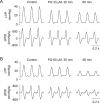Hemodynamic and electromechanical effects of paraquat in rat heart
- PMID: 33793552
- PMCID: PMC8016255
- DOI: 10.1371/journal.pone.0234591
Hemodynamic and electromechanical effects of paraquat in rat heart
Abstract
Paraquat (PQ) is a highly lethal herbicide. Ingestion of large quantities of PQ usually results in cardiovascular collapse and eventual mortality. Recent pieces of evidence indicate possible involvement of oxidative stress- and inflammation-related factors in PQ-induced cardiac toxicity. However, little information exists on the relationship between hemodynamic and cardiac electromechanical effects involved in acute PQ poisoning. The present study investigated the effects of acute PQ exposure on hemodynamics and electrocardiogram (ECG) in vivo, left ventricular (LV) pressure in isolated hearts, as well as contractile and intracellular Ca2+ properties and ionic currents in ventricular myocytes in a rat model. In anesthetized rats, intravenous PQ administration (100 or 180 mg/kg) induced dose-dependent decreases in heart rate, blood pressure, and cardiac contractility (LV +dP/dtmax). Furthermore, PQ administration prolonged the PR, QRS, QT, and rate-corrected QT (QTc) intervals. In Langendorff-perfused isolated hearts, PQ (33 or 60 μM) decreased LV pressure and contractility (LV +dP/dtmax). PQ (10-60 μM) reduced the amplitudes of Ca2+ transients and fractional cell shortening in a concentration-dependent manner in isolated ventricular myocytes. Moreover, whole-cell patch-clamp experiments demonstrated that PQ decreased the current amplitude and availability of the transient outward K+ channel (Ito) and altered its gating kinetics. These results suggest that PQ-induced cardiotoxicity results mainly from diminished Ca2+ transients and inhibited K+ channels in cardiomyocytes, which lead to LV contractile force suppression and QTc interval prolongation. These findings should provide novel cues to understand PQ-induced cardiac suppression and electrical disturbances and may aid in the development of new treatment modalities.
Conflict of interest statement
The authors have declared that no competing interests exist.
Figures





Similar articles
-
Superior Efficacy of Lipid Emulsion Infusion Over Serum Alkalinization in Reversing Amitriptyline-Induced Cardiotoxicity in Guinea Pig.Anesth Analg. 2018 Apr;126(4):1159-1169. doi: 10.1213/ANE.0000000000002707. Anesth Analg. 2018. PMID: 29239964
-
Sodium channel-blocking properties of spiradoline, a kappa receptor agonist, are responsible for its antiarrhythmic action in the rat.J Cardiovasc Pharmacol. 1998 Dec;32(6):863-74. doi: 10.1097/00005344-199812000-00002. J Cardiovasc Pharmacol. 1998. PMID: 9869491
-
Vitamin E ameliorates the decremental effect of paraquat on cardiomyocyte contractility in rats.PLoS One. 2013;8(3):e57651. doi: 10.1371/journal.pone.0057651. Epub 2013 Mar 18. PLoS One. 2013. PMID: 23526948 Free PMC article.
-
Cardiac depression induced by cocaine or cocaethylene is alleviated by lipid emulsion more effectively than by sulfobutylether-β-cyclodextrin.Acad Emerg Med. 2015 May;22(5):508-17. doi: 10.1111/acem.12657. Epub 2015 Apr 23. Acad Emerg Med. 2015. PMID: 25908403 Free PMC article.
-
Electrophysiological mechanisms for antiarrhythmic efficacy and positive inotropy of liriodenine, a natural aporphine alkaloid from Fissistigma glaucescens.Br J Pharmacol. 1996 Aug;118(7):1571-83. doi: 10.1111/j.1476-5381.1996.tb15577.x. Br J Pharmacol. 1996. PMID: 8842417 Free PMC article.
Cited by
-
Early vs. delayed QTc prolongation in acute poisoning: A prognostic accuracy study-A case series.PLoS One. 2024 Sep 10;19(9):e0309940. doi: 10.1371/journal.pone.0309940. eCollection 2024. PLoS One. 2024. PMID: 39255304 Free PMC article.
-
Unraveling the link between severe bradycardia and paraquat poisoning.Clin Exp Emerg Med. 2024 Mar;11(1):117-119. doi: 10.15441/ceem.23.068. Epub 2024 Jan 11. Clin Exp Emerg Med. 2024. PMID: 38204158 Free PMC article. No abstract available.
-
General anesthesia and electrocardiographic parameters in in vivo experiments involving rats.Physiol Res. 2022 Apr 30;71(2):177-192. doi: 10.33549/physiolres.934848. Epub 2022 Apr 11. Physiol Res. 2022. PMID: 35275702 Free PMC article.
References
Publication types
MeSH terms
Substances
LinkOut - more resources
Full Text Sources
Other Literature Sources
Research Materials
Miscellaneous

